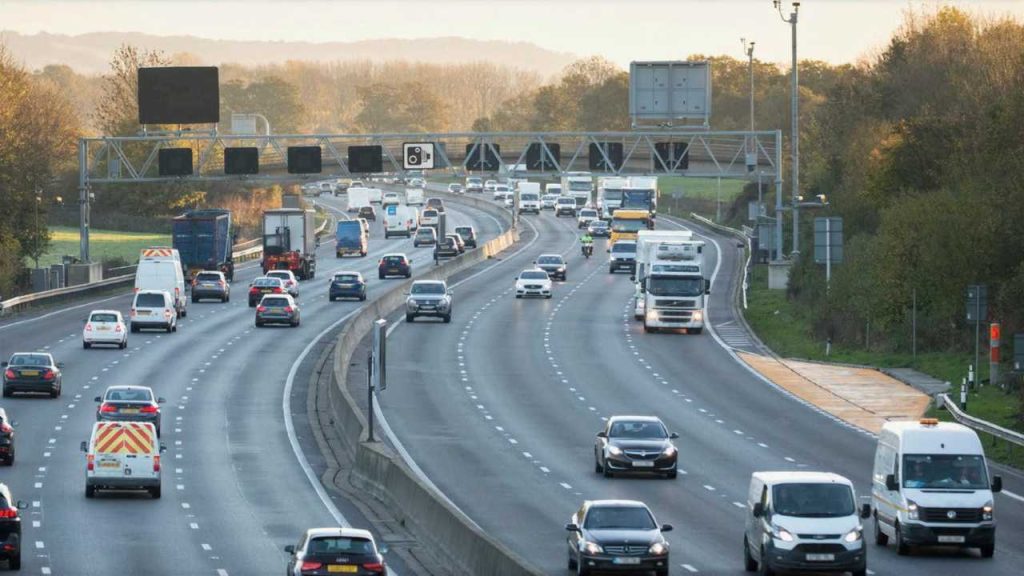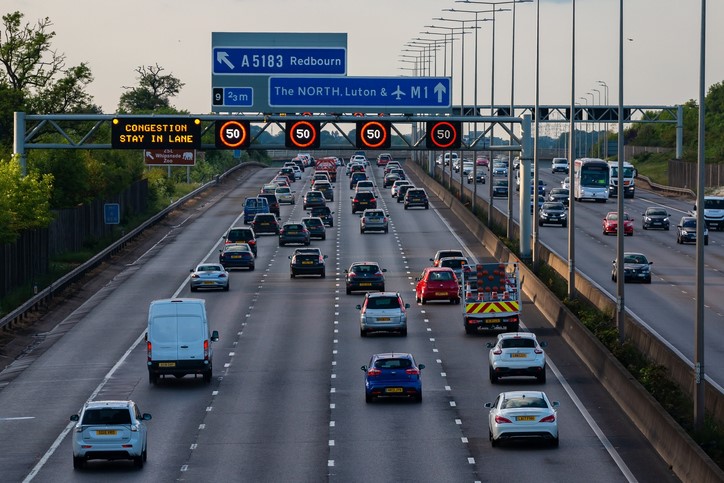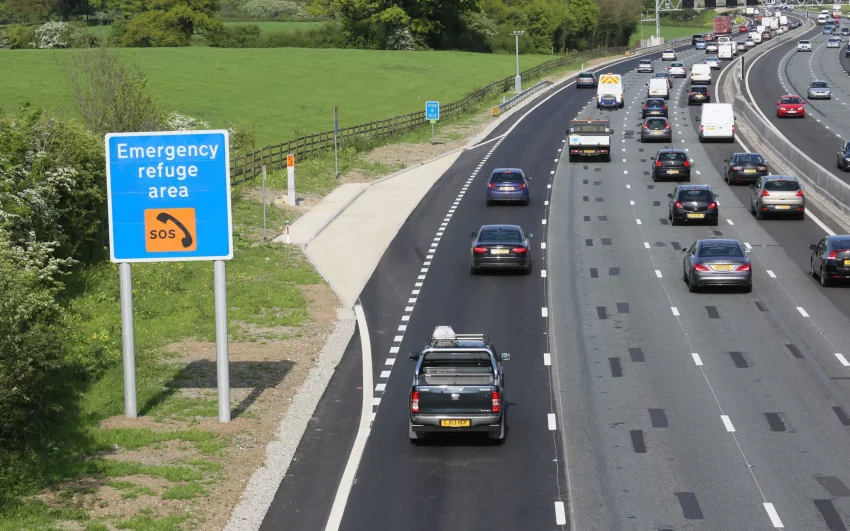A running lane on a motorway is a specialized traffic lane designed to manage and optimize the flow of vehicles during periods of high congestion. It differs from standard lanes in that it can be activated or deactivated as needed to accommodate varying traffic conditions.
When activated, a running lane increases the total number of available lanes for traffic, providing temporary relief from congestion. It is typically used during peak traffic hours, special events, or emergencies to enhance traffic flow.
Running lanes are marked by specific road signs and lane markings, and their use is governed by strict regulations to ensure safety. The goal of running lanes is to reduce traffic congestion, enhance road safety, and improve overall transportation efficiency.
What Are The Purposes of Running Lanes on a Motorway?

Running lanes on a motorway serve several essential purposes in traffic management. These lanes are strategically designed to ensure the efficient flow of traffic, enhance safety, and contribute to a smoother driving experience for all motorists.
Maintaining Traffic Flow
One of the primary purposes of running lanes is to maintain a consistent flow of traffic on the motorway. Unlike other lanes with specific purposes, such as overtaking slower vehicles or exiting the highway, running lanes are intended for general use. They help prevent congestion and traffic jams by allowing vehicles to move steadily.
Reducing Congestion
Running lanes play a crucial role in reducing traffic congestion, especially during peak hours. By providing an additional lane for vehicles to use, they help distribute the flow of traffic more evenly, minimizing bottlenecks and delays.
Enhancing Safety
Safety is a paramount concern on the motorway. Running lanes contribute to a safer driving experience by preventing abrupt lane changes and reducing the chances of collisions. When used correctly, they promote a more predictable and organized traffic pattern.
Optimizing Capacity
Running lanes increase the overall capacity of the motorway. They accommodate a greater number of vehicles, which is particularly beneficial during busy periods. This optimization of capacity helps prevent gridlock and ensures that the motorway can handle high volumes of traffic efficiently.
Adapting to Traffic Needs
Running lanes are a flexible solution that can be opened or closed as needed. They are often employed during peak traffic hours to address increased demand for road space. This adaptability ensures that traffic management authorities can respond to changing traffic patterns effectively.
Improving Travel Times
By promoting a steady flow of traffic, running lanes help improve travel times for all motorists. Commuters can reach their destinations more quickly and predictably, reducing the frustration often associated with lengthy delays.
How to Identify Running Lanes on a Motorway?
Identifying running lanes on a motorway is crucial for safe and efficient driving. These lanes are typically marked and signaled using specific visual cues to inform drivers of their status.
First and foremost, pay close attention to road signs as you approach a motorway. Look for electronic overhead signs displaying a green arrow, which indicates that a running lane is active and open for use. Conversely, a red “X” symbol indicates that the running lane is closed and should not be used.
Moreover, running lanes are demarcated by white lane markings on the road surface. These markings are distinct from standard lanes and usually consist of a solid white line, often accompanied by symbols or text indicating that it is a running lane.
In some regions, overhead signals with lane-specific indications may be present. These signals display a green arrow when the running lane is open and a red “X” when it is closed.
As well as look for dedicated signage placed alongside the road or on overhead gantries. These signs will provide information about the status of the running lane, such as “Active” or “Closed.”
Some motorways feature lane control signals mounted above the lanes. These signals display lane-specific information and may include green or red indicators to signify whether the running lane is open or closed.
Which Types of Running Lanes Are Found on Motorways?
Running lanes come in various types, each designed to address specific traffic management needs and improve the flow of vehicles on the motorways. These types of running lanes are implemented strategically to optimize capacity, enhance safety, and reduce congestion
Hard Shoulder Running (HSR)
- In HSR, the hard shoulder serves as a temporary running lane, primarily during rush hours or special events when traffic volume surges. This adaptive approach helps manage congestion efficiently without costly infrastructure changes.
- Emergency refuge areas are strategically placed at regular intervals, ensuring that drivers have a safe place to stop in case of vehicle breakdowns or emergencies. Lane control signals overhead indicate the status of the hard shoulder, guiding drivers.
All-Lane Running (ALR)
- ALR is a more permanent solution where the hard shoulder is consistently used as a running lane. This configuration increases the motorway’s capacity, making it suitable for handling heavy and consistent traffic loads.
- Emergency refuge areas remain a key safety feature in ALR systems, ensuring that motorists can find assistance or shelter if needed.
Dynamic Hard Shoulder Running (DHSR)
- DHSR provides the flexibility to open the hard shoulder during peak hours when congestion is common. It adjusts to changing traffic patterns and reduces traffic bottlenecks.
- Variable message signs and lane control signals are instrumental in managing traffic flow. They inform drivers when the hard shoulder is available, ensuring safe and coordinated lane changes.
Controlled Access (Express) Lanes
- These lanes are separated from regular lanes by physical barriers, ramps, or dedicated roadways. They typically serve specific vehicles, such as buses or high-occupancy vehicles.
- Controlled access lanes provide a reliable route for these vehicles, reducing congestion and encouraging alternative transportation options.
Buffered Lanes
- Buffered lanes are physically separated from regular lanes by either concrete barriers or painted buffer zones. The buffer adds an extra layer of safety for drivers.
- In the event of minor incidents or breakdowns, the buffer zone allows vehicles to pull over without obstructing traffic, enhancing safety and traffic flow.
Toll Lanes (Managed Lanes)
- These lanes require a fee for use, offering a faster and more predictable route for those willing to pay. Toll revenue contributes to infrastructure maintenance and upgrades.
- Managed lanes provide an option for drivers who prioritize a reliable and expedited commute.
High-Occupancy Vehicle (HOV) Lanes
- Reserved for vehicles with multiple occupants, such as carpoolers or public transit, HOV lanes promote ridesharing and reduce congestion.
- These lanes encourage eco-friendly and efficient transportation options by prioritizing vehicles with more passengers.
When and How to Use Running Lanes on Motorways?

Running lanes are typically activated during peak traffic hours when congestion is high. Be alert to overhead signs indicating when the running lane is in use.
Also, pay attention to lane control signals, usually displayed above the lanes, to determine the status of the running lane. Green means it’s open for use, while a red X indicates closure.
Do not use the hard shoulder unless it is specifically designated as a running lane. Outside of designated hours or areas, the hard shoulder is for emergency use only.
As well as familiarize yourself with the location of emergency refuge areas, which are spaced at intervals. These areas provide a safe place to stop in case of vehicle breakdowns or emergencies.
Additionally, try to maintain speed limits, which may vary depending on the traffic conditions. Reducing speed in congested areas helps maintain safety.
When merging into or out of a running lane, exercise caution and follow the guidance of road signs and lane control signals.
Moreover, avoid overtaking other vehicles within a running lane. Running lanes are primarily designed to ease congestion, not for high-speed passing.
Once you enter a running lane, stay in it and do not change lanes within the lane itself. Wait until it’s safe to merge into a regular lane.
If you encounter an emergency vehicle with lights and sirens on, exit the running lane as soon as it’s safe to do so to clear the way.
Always be alert, focused, and considerate of other drivers. Running lanes are designed to enhance safety and traffic flow when used properly.
FAQ
Which lane is the fast lane in the UK?
In the UK, the fast lane, also known as the overtaking lane, is typically the rightmost lane on a motorway or multi-lane road.
Which lane is best in heavy traffic?
In heavy traffic, the best lane to use is usually the lane that is flowing most smoothly. This may vary depending on the specific traffic conditions at the time.
Which lane is the fastest?
The fastest lane on a motorway in the UK is the rightmost lane, which is used for overtaking slower-moving vehicles.
What is a slow lane in England?
In England, the slow lane is generally the leftmost lane on a motorway or multi-lane road, which is used for normal driving at a steady pace.
What is the longest lane in England?
The longest lane in England, as well as the rest of the UK, is typically the rightmost overtaking lane on a motorway.
Which lane is best in traffic in the UK?
In the UK, the best lane to use in traffic may vary depending on the specific traffic conditions. It is advisable to choose the lane that is flowing most smoothly to maintain a steady pace.
Why do people drive in the middle lane in the UK?
Some people drive in the middle lane in the UK due to various reasons, including habit, lack of awareness of lane discipline, or because they may be planning to overtake vehicles in the left lane.
Why are there 3 lanes on a motorway?
Motorways in the UK have three lanes to accommodate a greater volume of traffic, provide opportunities for overtaking slower vehicles, and improve traffic flow.
Why is it right-hand drive in the UK?
Right-hand drive in the UK is a historical legacy, dating back to the days of horse-drawn carriages when drivers would sit on the right to have a better view of the road.
Which lane to use on a motorway in the UK?
On a motorway in the UK, it is generally recommended to use the left lane for normal driving and use the rightmost lane (fast lane) for overtaking slower vehicles.
Final words
All things considered, a running lane on a motorway is a valuable tool for managing traffic flow and reducing congestion during peak hours. This dynamic lane, often indicated by overhead signs and lane control signals, offers a flexible solution to enhance the efficiency of our roadways. While it’s important to understand the rules and safety considerations associated with running lanes, they play a crucial role in ensuring smoother journeys for all drivers.
By staying informed, following road signs, and practicing safe driving habits, we can make the most of running lanes while contributing to safer and more efficient travel on our motorways. So, next time you encounter a running lane, remember that it’s designed to help you reach your destination with fewer delays and less traffic stress. Safe travels!

